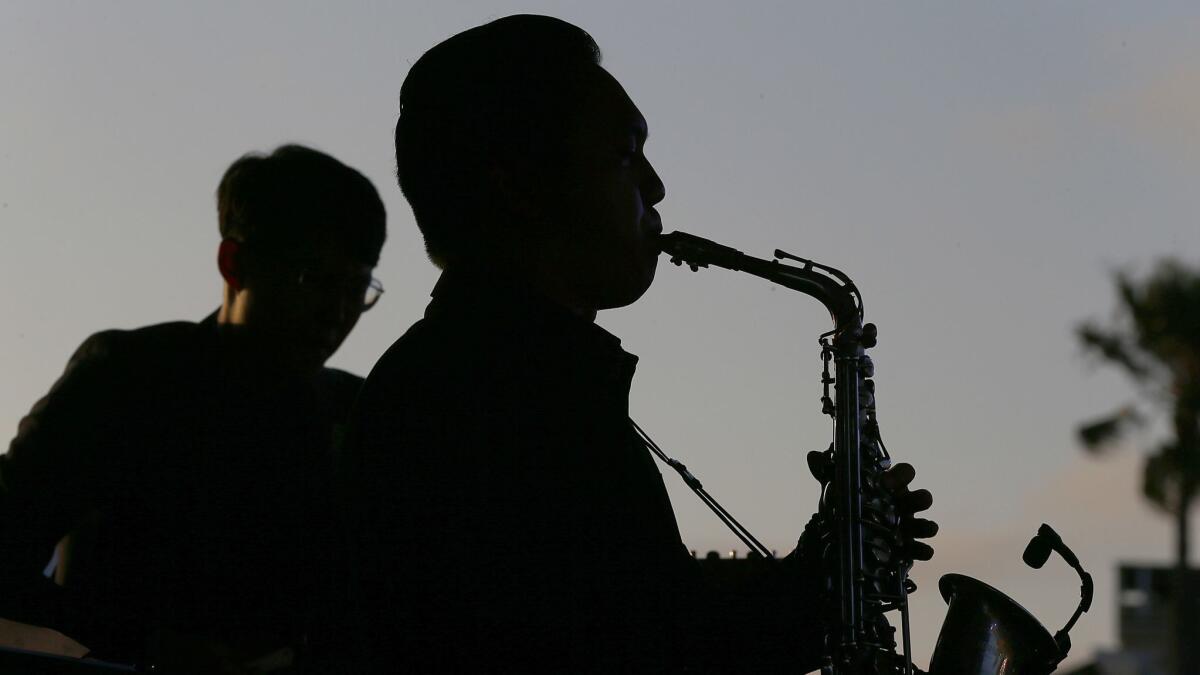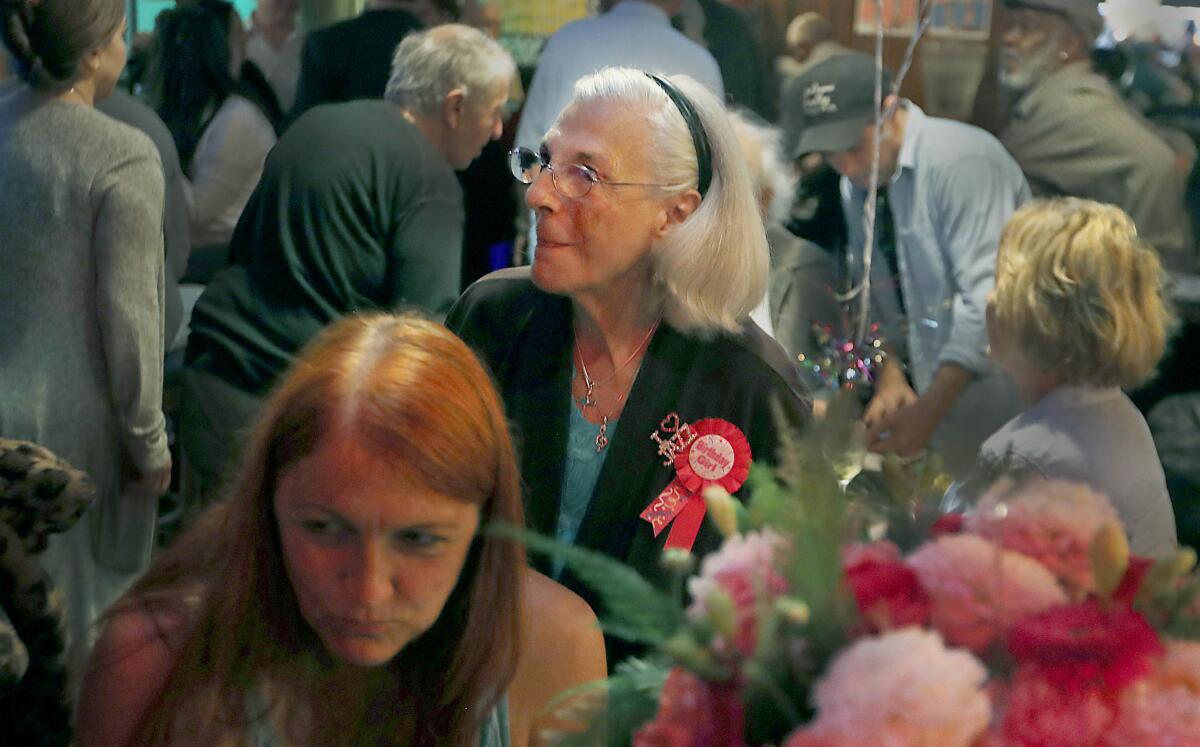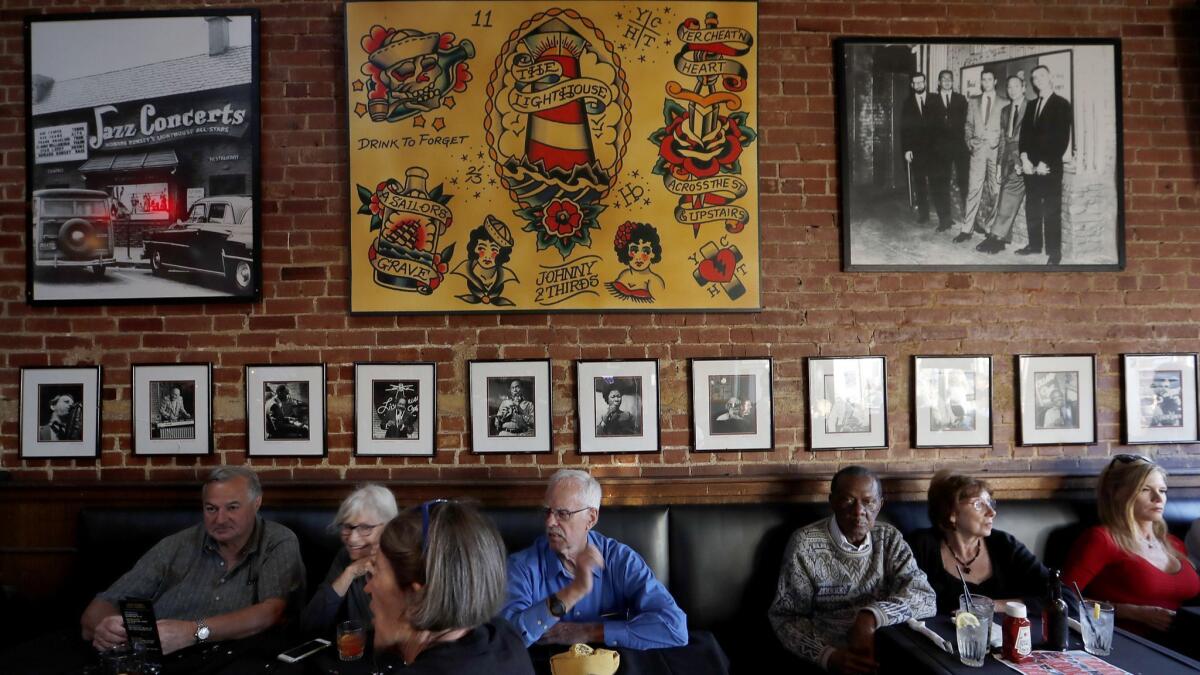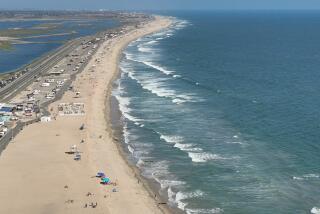Her husband was an L.A. jazz legend. At 94, she’s becoming one herself

Saxophonist Charles Owens’ quartet was onstage blowing a hard blues as part of the 70th anniversary celebration of Hermosa Beach’s historic Lighthouse Café jazz jam when Gloria Cadena stood up from her table.
She was clutching a manila folder full of papers and approached the stage. She whispered something into Owens’ ear and then moved the tip bucket closer to the front of the stage. That day, June 26, was her 94th birthday, but Cadena wasn’t really at the club to celebrate. She was there to work.
“I was always in the background, calling the musicians and helping my husband book,” said Cadena, the Lighthouse’s resident jazz promoter, between sets but before cake. “He died in 2008 but I’m still doing the same things.” Since Ozzie’s death, she does those tasks alone: booking, promoting and even greeting folks at the door.
She pointed across the room at a black-and-white framed picture on the wall of a young man and woman, Gloria and Ozzie Cadena. “That’s us on our wedding day, 1950.”

For nearly 20 years, the Cadenas were the most influential jazz promoters in the South Bay, booking the Lighthouse on occasion as well as other beachy venues like the now-defunct Sangria.
The summer before the Cadenas got married, the sand-strewn doorway of Hermosa Beach’s Lighthouse first lit up the swinging beacon that would come to define an entire genre of music from San Diego to Seattle. Never mind the fact that Los Angeles had a homegrown jazz scene stretching back before Prohibition or that during World War II, Central Avenue was a 24-hour neighborhood boasting sessions by neighborhood kids like Dexter Gordon, Charles Mingus and Buddy Collette. For much of the world, the West Coast jazz aesthetic was defined when bassist Howard Rumsey hosted his first Sunday jam session in the flailing, brick-lined, sun-dappled bar.
Seventy years later, the phrase “West Coast Jazz” still conjures seagulls and short-sleeves and the Lighthouse still swings on Sunday mornings. But for one hour on a Wednesday, as the sun set beyond the volleyball nets, the bustling Hermosa Beach Pier Plaza lit up with the sounds of contemporary jazz compliments of local pianist David Benoit and his quintet. Several hundred flip-flop-clad dog walkers and huddled tourists filled the fold-out chairs, the brisk un-summer temperatures helping to sell a few souvenir sweatshirts.
Earlier in the day, KKJZ broadcast live from the plaza, celebrating the Lighthouse’s anniversary and Gloria Cadena’s birthday with those who couldn’t find cheap beach parking. While Benoit played to the sand, inside the Lighthouse was a rotating collection of musicians taking the stage to honor the Cadenas and the decades of jazz history held in the narrow club. There were two cakes made to celebrate the milestones.
In 1949, Rumsey’s jam session was a quick success, attracting musicians like Miles Davis, Chet Baker and Gerry Mulligan throughout the next couple decades. The session could sometimes last more than half a day and more than two dozen albums were recorded in the club by the likes of Lee Morgan, Elvin Jones and the Jazz Crusaders. The club became known as the “Jazz Corner of the West,” an inverted Village Vanguard with more sunburns and fewer people falling down the stairs.
By the time Ozzie Cadena arrived in California from Newark, N.J., jazz at the Lighthouse had been running for a quarter century and Rumsey had moved on to his Concerts by the Sea venture. Cadena was not alone when he moved. He brought Gloria and his children, including his restless adolescent son Dez, who would go on to blow out his larynx with the L.A. hardcore band Black Flag before he gave up vocal duties to Henry Rollins, and who’d later become a fixture, as guitarist, with horror-punk group the Misfits. He has since moved back to New Jersey but continues to play including with numerous bands including a group called FLAG composed of past members of Black Flag.
“In the beginning of 1974, Dad just came home one day and said, ‘In June, we are moving to California,’” recalls a raspy Dez Cadena, now 58. “My mom said, ‘Where?’ He had fallen in love with Hermosa Beach. It wasn’t even L.A. It was Hermosa Beach. And the Lighthouse.”
The elder Cadena had been an A&R man for Savoy Records from 1954 to 1959. He arranged sessions for Milt Jackson and Cannonball Adderley at the behest of tyrannical label owner Herman Lubinsky. He went on to produce soul-jazz classics for Prestige Records while running a successful record store in the Garden State. He became enraptured with Hermosa Beach while visiting California for a Fantasy Records session in Berkeley. Old friends from New Jersey like musicians Yusef Lateef and Charles Earland would stay with the Cadenas when they would swing out west on tour.
While Ozzie spent his youth on the engineer’s side of the studio, Dez was making musical waves of his own in town. “The parallels between punk rock and jazz music are extremely close. Jazz was looked down upon in my dad’s day. With punk rock, nobody could figure us out. Even the hippies couldn’t figure us out and the city certainly couldn’t figure us out.”
Dez’s generational détente reached its peak in 1980 when Black Flag hosted a gig at the Church, a former Baptist church only blocks away from the Lighthouse that had become a squatters’ home to South Bay punk pioneers like Redd Kross and the Descendants. In a swift embrace of negative press, Black Flag got themselves kicked out of Hermosa Beach for riotous behavior. All the while, Cadena’s parents were wrestling with preserving the musical legacy of the generation before — older, more sharply dressed but no less angry.
It wasn’t until the late 1980s, after the club was bought by its current owner, South Bay restaurateur Paul Hennessy, that the Cadenas started booking at the Lighthouse. Their first act? Woody Herman. For the next 20 years, the Cadenas would go on to protect the legacy of the Lighthouse, hiring top local talent and helping to install a series of plaques in the plaza commemorating visitations from swinging dignitaries like the Jazz Messengers as well as the home team, Howard Rumsey’s Lighthouse All-Stars which featured more than 50 musicians over the years, including Hampton Hawes, Sonny Criss and Max Roach.
To kick off the festivities last month, Ozzie and Gloria were honored by the city of Hermosa Beach. Mayor pro tem Mary Campbell unveiled a plaque entitled “The Promoters,” recognizing their importance to the history of jazz on both coasts. Nearly 100 people gathered for the short ceremony in the middle of the plaza.

Gloria stood quietly listening to guests like Owens and guitarist Jacques Lesure say a few nice things about her. She seemed more preoccupied with the gig than the family members who had gathered to help celebrate. After a round of “Happy Birthday,” Gloria briefly took the microphone. “Let’s keep the jazz going!” she announced before returning to her table at the front of the stage.
“I get the feeling if Ozzie was around he would say something like, ‘Oh, don’t bother with me. It’s for the musicians,’” says Dez. “That’s what he always said. That’s why he did the things he did. He always fought for the musicians. Hermosa is a beach party town with a lot of young people. The clubs want to make money, sell drinks. That’s why they started booking reggae and rock.”
Of course, it takes more than just a dedication to jazz to keep a nightclub filled at 6 p.m. on a Wednesday in a youthful beach town. The calendar at the Lighthouse boasts live-band karaoke and salsa night, but jazz keeps itself in the rotation three days a week.
There are several framed images before the L-shaped hallway that leads to the back parking lot. Ozzie is in one working the club. Gloria is the photo next to him. Beside that is a large, signed movie poster for the Oscar-winning 2016 film “La La Land.” The suburban, hard-bop Technicolor fantasy made good use of the Lighthouse and subsequently breathed life into the club, attracting a few lookie-loos who are less concerned with Duke Ellington’s small ensemble work than they are with where Ryan Gosling may have checked his phone while waiting for film to roll. Either way, business is good and jazz musicians still have a reliable gig in town.
Toward the end of the plaza, there is a mural adorned with flowers and surfers. Howard Rumsey with his upright bass is front and center next to Chet Baker. To their left, above the mermaid, is Black Flag. Onstage and off, the Cadenas’ legacy is everywhere in Hermosa Beach — from the spike-haired skate rats riding on the pier to the embossed brass plaques proclaiming “JAZZ.”
“I just wish my husband was here to enjoy this,” said Gloria amid the crowd of familiar faces. “I did it to keep it all going. I mean, what else would I do?”
More to Read
The biggest entertainment stories
Get our big stories about Hollywood, film, television, music, arts, culture and more right in your inbox as soon as they publish.
You may occasionally receive promotional content from the Los Angeles Times.








